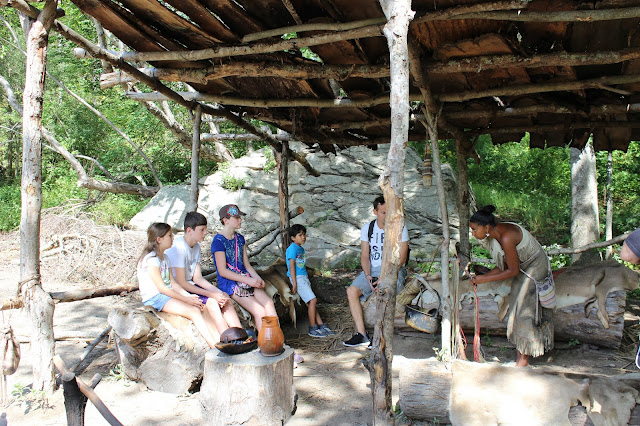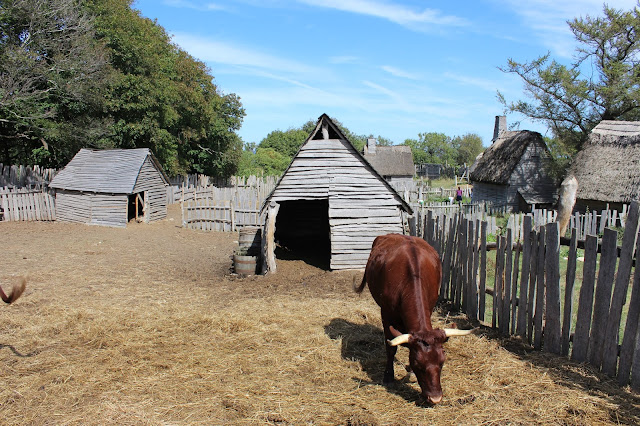At Plimoth Plantation, there is a winding trail that leads you to several points along the way. The first was the Wampanoag Homesite. This is a replica homesite of the way these people would have lived in the 17th century. The people there, however, are not "role-playing". They are actually Native American, but dressed in historical clothing. They talk to you about the history from a modern perspective. In contrast, the people in the English village role-play as if they were from that time.
I don't remember what this was, but there were toys on the ground that the kids got to pick up and play with. One had hollow bones attached to a string, which was attached to a stick and you swing the bones into the air and try to catch them on the stick. Brady was the only one to do it successfully!
These guys were building a "house". This homesite was a replica of where they would have lived during the growing season, aka, "not winter". This would allow a breeze through.
This is the type of house they would live in during the winter and it would be several miles inland away from the river in the forest. I assume to protect against the wind and bad weather. That is bark used for insulation and there were two fires inside with two smoke holes in the ceiling.
Brady is sitting on one of the beds inside the winter home, covered in furs. Underneath the beds was loads of firewood. There was a guy in there answering questions and explaining everything to us.
The cooking area. She had a pot over the fire with two whole crabs and a piece of corn. She was also making a belt.
Just down the trail was the 17th century English village. I believe this is set in 1626, so just a few years after the colonists arrived on the Mayflower. These people took it seriously and never broke character. When one colonist asked where we were from and one of the kids said "Texas", she replied, "I've never heard of that place." They had also never heard of ice cream, yogurt, nor an RV (which he asked if it was like a wagon). It was pretty fun listening to them tell stories and go about their lives, which primarily consisted of cooking or building something.
This was a fort at the initial entrance to the village on the second story.
This lady had great stories and was cooking some kind of fried bread with butter. It smelled great and I think Brady was expecting a sample. It was comfortable outside, but inside these houses with the fires going it was pretty warm and with all her clothes on, she was sweating and constantly wiping her face on her apron. I felt bad for her.
I didn't take any pictures, but in the craft center, which had people making things from the time period, there was an artisan baking bread. We bought a loaf for $5 and it was pretty good. It was the type with a very crispy, almost crunchy outside and a very soft inside.
We drove the two or three miles from Plimoth Plantation back into town and parked at the same free parking lot we found last night and walked down the trail again into town. We just went directly to the Mayflower II this time because it was getting later in the afternoon and the grist mill closes at 5:00. The most amazing thing about the ship, to me, was that it carried 102 passengers plus approximately 30 crew. 132 people on a ship of this size would be miserable, especially across the ocean for more than two months. They ended up arriving in November (very unfortunate) and more than half of them died within a year. Pretty rough start.
This guy was also role-playing and the kids loved talking to him, asking him questions, and listening to his stories. He was funny, and played up the sexism of the time saying things like, "an educated woman is like a tame fox, dangerous."
After a second stop at the Plimoth Candy Company, we made our last stop of the day at the grist mill, which is still operational two days per week, although not today. The original grist mill on this site was built in 1636, so the Pilgrims went without one for 16 years, a luxury they were accustomed to back home. Each house in the English village we saw earlier in the day had a mortar and pestle. This lady was very good and explained how everything works. I thought it was fascinating how simple machines allow one person to operate and move these 2500 pound stones.
This was downstairs and you can see the gears. The large wheel at the back with the teeth facing you is directly attached to the water wheel outside. The smaller gear orthogonal to it is what drives the top stone upstairs. The speed of operation and the distance between the two stones can all be fine tuned.
When we got home, we finally put up the hammock.
I was planning on going into Boston tomorrow, but it's late and I have yet to figure out how we get into town on the train and subway and what time they leave, so we may just hang out here and catch up on work tomorrow.



















Entertaining! Inviting hammock.
ReplyDelete